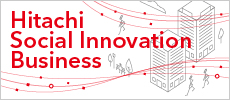Buildings SystemsConnective Industries
1. Developing Modernization Products to Provide New Value to Existing Customers
Starting around 1999, elevators without a machine room at the top of the shaft became the mainstream in Japan and Hitachi introduced its standard machine-room-less elevator to the market. More than 20 years have passed since the early model of machine-room-less elevator, and it is now time for modernization. In response, Hitachi was among the first in the industry to develop and launch a modernization control product for machine-room-less elevators. The control modernization products of the early model of machine room-less elevator, the installation of a double-brake mechanism for the traction machine, as well as unintended car movement protection (UCMP), which enhances safety and meets the need for improved resilience in the event of a disaster. In addition, modernization is promoted with improved visibility and a design refresh (released in April 2024).
Additionally, Hitachi has developed and is offering control modernization products for four-person elevator designed for low to mid-rise buildings and equipped with a winding drum machine, which was delivered between 1983 and 2000. The control method unique to drum-type elevators, and the brake safety enhancement features of the drum-type machine have been adopted. This product configuration is designed for minimal equipment updates for discontinued parts, resulting for a low-cost and short-duration modernization. At the same time, improvements in visibility and design are emphasized through a refresh of components such as the operation panel (released in March 2022).
[01]Overview of the Control Modernization Products of the Early Model of Machine-room-less Elevator![[01]Overview of the Control Modernization Products of the Early Model of Machine-room-less Elevator](/rev/archive/2025/01/08/image/fig_01.png) IC: integrated circuit
IC: integrated circuit
2. Innovation in Elevator Construction Technology to Address Japan’s 2024 Problem
In the construction industry, in addition to the chronic issue of labor shortages, there are concerns about an increase in construction site closures due to the implementation of the regulation capping overtime hours starting on April 1, 2024, which is referred to as the 2024 problem. This is expected to lead to issues such as longer construction periods due to a shortage of skilled workers.
As a new technology to shorten the construction period for elevator installation work, Hitachi Building Systems Co., Ltd. has developed an installation position adjustment device that digitalizes the skills of experienced workers. This device consists of a rail position adjustment device that automates the positioning work for installing guide rails, which is essential for the smooth vertical movement of the elevator, and a landing sill (threshold) position adjustment device that automates the installation of the landing sill horizontally in relation to the building floor height. The system began operation with the standard elevator model released in April 2023.
With the application of this device, the work time for these tasks has been reduced by approximately 30% compared to conventional methods, and even less experienced workers can perform the tasks more quickly and accurately. Hitachi Building Systems, Ltd. aims to mitigate the impact of the 2024 problem through the operation of this device.
(Hitachi Building Systems Co., Ltd.)
[02]Guide Rail Position Adjustment Device (left) and Hall Sill (Threshold) Position Adjustment Device (right)![[02]Guide Rail Position Adjustment Device (left) and Hall Sill (Threshold) Position Adjustment Device (right)](/rev/archive/2025/01/08/image/fig_02.png)
3. “BuilMirai” Building IoT Solution for Small and Medium-sized Buildings
Hitachi has developed a new model of Lumada’s “BuilMirai” building Internet of Things (IoT) solution specifically for small and medium-sized buildings (hereinafter referred to as “this solution”) that aims to improve building management efficiency, maintain and improve operational quality, and enhance user comfort.
This solution is a package of solutions required by small and medium-sized buildings based on the technology, experience, and know-how that Hitachi has accumulated through the development and provision of “BuilMirai” for large buildings. Hitachi Building Systems will provide the solution as a service. As a first step, it will offer three solutions, all available via smartphones, to pass through security points at apartments, monitor building facilities for malfunctions, and monitor security camera imagery. The company will of the solution via subscriptions (monthly service) that customers can select as needed, reducing their investment burden and supporting the green transformation (GX) and digital transformation (DX) of small and medium-sized buildings.
[03]Overview of BuilMirai for Small and Medium-sized Buildings (Usage Scenario in an Apartment Building)![[03]Overview of BuilMirai for Small and Medium-sized Buildings (Usage Scenario in an Apartment Building)](/rev/archive/2025/01/08/image/fig_03.png)
4. CA Series Elevators Equipped with a Next-generation Control Platform Featuring Functional Safety Technology Integrated with Smart Buildings
Hitachi has launched a general passenger CA series of elevators, “MCA,” “LCA,” and “HCA,” for the Chinese market, featuring enhanced monitoring functions to achieve greater safety and security, and equipped with a control platform equipped with functional safety technology.
The newly developed functional safety technology converts the traditionally mechanical elevator safety devices and components into electronic systems using sensors and multiple microcomputers. The adoption of high-speed communication technology not only achieves high precision, safety, and reliability, but also reduces costs, enhances product competitiveness through space-saving, and balances environmental considerations by reducing the number of components and improving installation workability. In addition, the remote monitoring system constantly monitors the elevator’s status and provides new added value through the analysis of accumulated big data, thereby contributing to service businesses that integrate with smart buildings. Furthermore, this product serves as a core model that combines information technology (IT) and operational technology (OT) with a highly competitive product that is being deployed not only in China, but also globally.
[Hitachi Elevator (China) Co., Ltd.]
[04]Integration with Smart Buildings Using the Control Platform![[04]Integration with Smart Buildings Using the Control Platform](/rev/archive/2025/01/08/image/fig_04.png)



